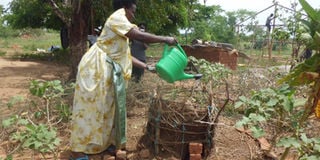Farmers embrace field schools to cope with climate change

Farmers are trained about kitchen gardening. PHOTO by Lominda Afedraru.
Several studies conducted on climate change and variability have confirmed that Uganda is vulnerable.
Climate change is expected to result in extreme and frequent periods of intense rainfall, erratic onset and interruption of the rains as well as frequent drought.
This has significant implications for agriculture, food security plus soil and water resources especially in the cattle corridor, where farmers regularly experience dry spells.
Therefore, various development partners, including UN Food and Agriculture Organisation (FAO), are involved in implementing the Global Climate Change Alliance (GCGA) project on agricultural adaptation to climate change. It is farmer field schools and community based integrated watershed management in Nakasongola district.
Conservation
FAO has been running the project in collaboration with Nakasongola District Farmers’ Association (Nadifa) since 2013 in three different sub-counties. These are Kakooge and Lwampanga where farmers form 25-30 member groups.
Each group identifies their area of interest such as maize, cassava or mushrooms, cattle keeping and forage production, citrus and mango seedling production, among others.
Andrew Atigei, the district project officer, explains that prior to implementation, the groups were trained on the advantage of conservation agriculture—where farmers do not till the land before planting but remove weeds.
He notes though that 60 years ago, the cattle corridor was covered with vegetation and spring wells, it is no longer the case. This is it has over-cultivated and over-grazed minus applying conservation agriculture mechanisms.
The interventions, therefore, include construction of underground water tanks with capacity of 10 million litres in Nakasongola, Luweero, Sembabule, Nakaseke and Kiboga districts.
Farmers are encouraged to grow drought-tolerant crop varieties such as maize, cassava and mushroom, and those engaged in animal husbandry to grow drought-tolerant pastures such as Calliandra calothyrsus and Chloris Gayana.
Demonstrations

Farmers are trained on how to make hay as some of the ways to cope with dry spells. PHOTO by Lominda Afedraru
Farmers are taught how to construct barns, which serve as storage facilities for their hay as well as water catchment during rainy seasons. The farmer field school owns 300 acres of land in Nakaseke for multiplying improved pasture, which farmers are adapting gradually.
John Peter Opio, a programme officer in Nakasongola District, reveals that 24 farmer field school groups have been trained in Rwampanga Sub-county.
They were trained on maize and cassava production—multiplication of clean seed which can be supplied to farmers —as well as production of citrus, mango (through grafting) and tomato seedlings.
This training is made practical by setting up demonstrations on selected farms belonging to farmers practising mixed farming with crop, livestock, vegetables and fruits plus water harvesting, among others.
This enables members of the farmer field school to learn the recommended farming methods from these demonstrations.
A number of farmers have been trained in back yard gardening where they are encouraged to grow vegetables for home consumption especially during prolonged dry spells.
farmers’ experiences with the field schools
Sarah Nalubega, a mixed farmer from Kyawakataka village in Nakasongola District:
“I grow crops such as cassava, maize and millet for home consumption and sale. Since they take between four to 12 months to mature, I do mushroom in between to get quick income.
How I got involved in the latter is an interesting story. Early last year, I was listening to a radio programme in which farmers were urged to engage in mushroom growing. They talked about the steps to follow. The radio programme was not convincing enough to me.
Later, a coordinator from Nadifa told me about a programme managed by FAO where farmers were being trained on how to grow mushroom.
I went and attended the training for a week; when I came back to my village, I managed to set up the seed multiplication items in my house. After a month, it was ready for planting. I constructed a grass-thatched shelter, which serves as the growth room.
We were five who attended the training but the number of mushroom growers in my village has increased to 10. I sell fresh mushrooms at Shs4,000 per kg but the dry ones fetchs more money because a kilo is Shs30,000.
In addition to mushroom farming, I have been trained on how to do kitchen gardening as well as rainwater harvesting.”
John Kyagaba, a mixed farmer but mainly majoring in cattle keeping and growing improved pasture:
“Brachiria and Calliandra calothyrsus were introduced in Nakasongola District to overcome the shortage of pastures during dry spells. This is a challenge for farmers in the cattle corridor.
For instance, this time the dry season lasted from last November to April 2016. It has caused massive destruction to my field where I planted Calliandra calothyrsus because the trees dried up.
When the rainy season starts, I will plant more pasture because when cows are fed on the improved species, they produce more milk compared to when they feed on the traditional pastures.
I have eight heads of cattle, with one cow producing milk for home consumption and for sale.
Previously, the cow produced a litre of milk per day but after introducing the improved pasture feed, it now produces five litres of milk daily.




